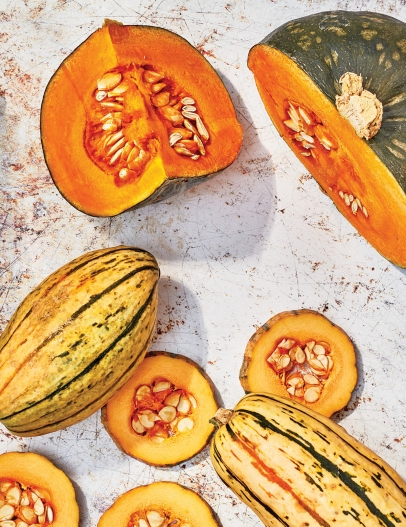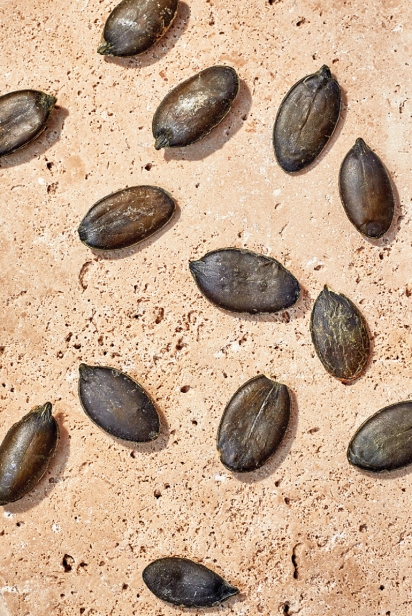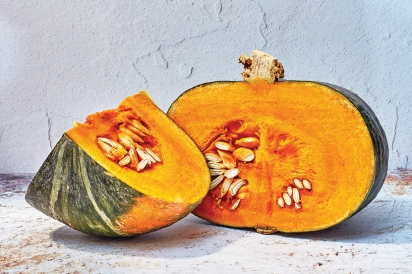Hard Squash
Embracing the Bounty of the Season: Winter Squash & Gourds
AS THE DAYS grow shorter and the air turns brisk, a transformation sweeps over the culinary landscape, marked by the transition from summer’s bounty to the fall harvest. During this season, flavors become richer, textures cozier and colors take on a deeper vibrancy—ushering in the arrival of winter squash.
Squashes belong to the gourd family of plants called Cucurbitaceae; the name cucurbita is Latin for gourd, and moschata is Latin for musky. This botanical family comprises annual or perennial herbs that originated in temperate and tropical regions, featuring an array of cucumbers, gourds, melons, squashes and pumpkins. Among them, winter squash, a warm-season annual vegetable vine, trails along the ground, or climbs up structures using tendrils.
Diverse winter squash varieties, including zucchini, kojinut, butternut and spaghetti squash, play a prominent role in various dishes. They are used in hearty soups and pasta dishes, as well as for stuffing with a mixture of grains, vegetables or light cheese before deep-frying them to perfection.
Rosebud Schneider, a seasoned farmer with Keep Growing Detroit, says harvesting typically begins by the end of September or early October, “depending on the number of days to maturity and when they were planted.”
“We know it’s time to harvest when the vines begin to wither and turn brown, especially those directly attached to the squash,” Schneider says. “To cure them, we usually leave them where they lay after cutting them and allow them to sit for about a week, depending on the weather conditions.”
Organizations like Keep Growing Detroit actively participate in cultivating a diverse array of winter squash. The current year’s harvest has yielded a splendid assortment of winter squash varieties, including the well-known butternut and the unique Candy Roaster type, celebrated for its oval shape, butternut-like flavor and lush and substantial interior.
Schneider fondly recalls a recent culinary experience. “We hosted our harvest dinner this year and slow-roasted the squash, cut into half-moon shapes about an inch and a half thick. After briefly slow-roasting them, we charred them on the grill and served them alongside wild rice and roasted apples. The flesh becomes exceptionally tender when cooked this way, making it an excellent way to enjoy all those rich nutrients.”
Candi Franklin, co-owner of CWO Farms, offers creative approaches to utilizing every part of the winter squash. “I make use of every part of the plant that’s edible. I have a chef friend who creates chimichurri from them. I stuff them like grape leaves. It’s mostly the butternut variety, but I’ll even take the stems and flowers, fill them with ricotta and deep-fry them.”
However, a hidden treasure in winter squash often goes unnoticed: its skin. While many recipes call for peeling winter squash, keeping the skin intact can elevate the nutritional value of dishes. The skin is a significant source of dietary fiber, crucial for digestive health and potentially assisting in weight management. It’s also rich in beta-carotene, the powerful antioxidant responsible for the gourd’s vibrant orange hue. Beta-carotene’s role in safeguarding the body from free radicals reduces the risk of chronic diseases and promotes overall health. By including the skin when preparing winter squash creations we maximize the intake of this essential nutrient.
Kate Morgan is the communications director for Make Food Not Waste, a nonprofit focusing on reducing food waste. She says to “definitely eat” the skin on squashes like acorn, delicata and honeynut, but avoid spaghetti squash since “the skin ends up being too tough.”
Winter squash is not only a versatile ingredient that can be used in a wide variety of applications, it also packs quite the nutritional punch, says registered dietitian Grace Derocha, who is a national spokesperson for the Academy of Nutrition and Dietetics.
“They’re rich in fiber, vitamin A, B, C, beta-carotene, minerals and antioxidants. This punch of nutrition has illustrated that incorporating them into one’s diet could help improve overall health and fight chronic conditions [such as] heart disease, cancers and type 2 diabetes. In addition, they strengthen vision, improve digestion and help the body rid itself of waste.”
Beyond the culinary realm, winter squash also holds cultural significance for Indigenous people across the Americas, who have an enduring connection to the cherished crop. This is evident in the “Three Sisters” farming technique. This agricultural cornerstone, practiced by many Native American tribes, involves planting corn, beans and squash together. This holistic approach maximized yields and ensured a nutritionally balanced diet for these communities. With its remarkable storability, winter squash played a pivotal role in sustaining Indigenous populations during the harsh winter months, making it a key to their survival.
Schneider emphasizes the importance of sourcing seeds from reputable suppliers, with a preference for organic varieties or saving seeds from the previous year. This practice not only fosters sustainability but also preserves the unique characteristics of local varieties. Cultivating a thriving winter squash crop involves ensuring nutrient-rich soil, appropriate amendments and regular composting. Early-season weeding is essential, and introducing a weed barrier can be a game-changing strategy. Moreover, ensuring these gourds have access to abundant water and sunlight is vital for their successful growth.
The enduring freshness of winter squash results from several key factors working in harmony. Its robust, thick skin acts as a natural shield, keeping the contents intact and protected. Low moisture content prevents premature spoilage, while the dense flesh ensures longevity. Nutrient density further adds to its long shelf life. Protective wax coatings provide an additional layer of defense against the elements. However, it’s not just these inherent qualities that preserve winter squash; proper storage conditions and handling are essential to ensure it remains fresh for an extended period.
Schneider advises, “A cool, dry place is ideal, such as a basement or root cellar. Storing them in your kitchen is fine for a month or two, but it’s best to keep them in a cool, dry place away from pets and other potential disturbances.”
Winter squash is a versatile canvas, available in various shapes, sizes and flavors, suitable for various culinary applications. It transforms from a simple vegetable into a symbol of well-being and culinary ingenuity. Whether it’s the buttery sweetness of butternut, the earthy richness of acorn or the robust flavor of kabocha, these versatile vegetables add a delightful and comforting touch to many dishes, making them popular ingredients in both savory and sweet recipes.
Keep Growing Detroit
detroitagriculture.net
Make Food Not Waste
makefoodnotwaste.org
Corn Wine and Oil Farms (CWO Farms)
instagram.com/cornwineoil_42n83w
Courtney Burk is a writer whose work primarily focuses on the hospitality industry across metro Detroit. Being a restaurant kid, she found her love of storytelling through food and the narratives of those within the industry. When she’s not writing, she can be found in the garden, working on new projects with her husband and enjoying the Great Lakes with her rescue mutts. Visit yeahnoforsure.co to check out her work.







